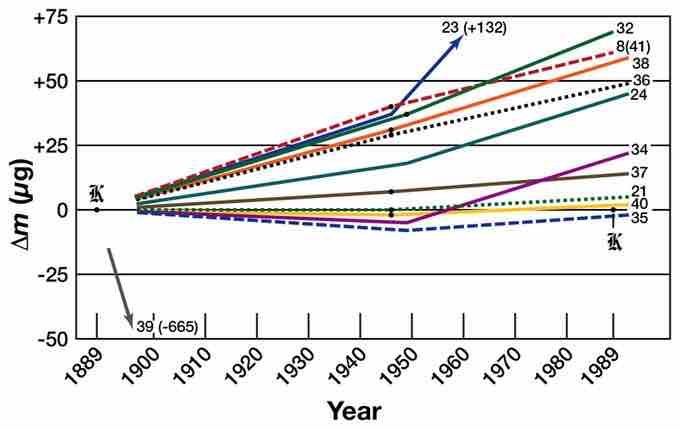Mass
Mass, specifically inertial mass, is a quantitative measure of an object's resistance to acceleration. It is an intrinsic property of an object and does not change because of the environment. The SI unit of mass is the kilogram (kg).
The kilogram is defined as being equal to the mass of the International Prototype Kilogram (IPK), which is almost exactly equal to the mass of one liter of water. It is also the only SI unit that is directly defined by an artifact, rather than a fundamental physical property that can be reproduced in different laboratories. Four of the seven base units in the SI system are defined relative to the kilogram, so the stability of this measurement is crucial for accurate and consistent measurements.
In 2005, the International Committee for Weights and Measures (CIPM) recommended that the kilogram be redefined in terms of a fundamental constant of nature, due to evidence that the International Prototype Kilogram will vary in mass over time . At its 2011 meeting, the General Conference on Weights and Measures (CGPM) agreed that the kilogram should be redefined in terms of the Planck constant. The conference deferred a final decision until its next meeting in 2014.

Prototype Mass Drifts
A graph of the relative change in mass of selected kilogram prototypes.
Mass and Weight
In everyday usage, the mass of an object in kilograms is often referred to as its weight. This value, though given in kilograms, is actually the non-SI unit of measure known as the kilogram-force. In scientific terms, 'weight' refers to the gravitational force acting on a given body. This measurement changes depending on the gravitational pull of the opposing body. For example, a person's weight on the Earth is different than a person's weight on the moon because of the differences in the gravitational pull of each body. In contrast, the mass of an object is an intrinsic property and remains the same regardless of gravitational fields. Accordingly, astronauts in microgravity must exert 10 times more force to accelerate a 10-kg object at the same rate as a 1-kg object, even though the differences in weight are imperceptible.